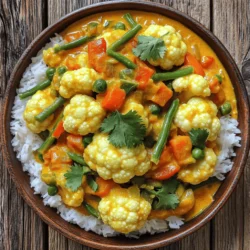Craving a warm, comforting meal? My Vegetable Curry Delightful and Nutritious Recipe has you covered! This easy dish is packed with flavor and nutrients, making it a perfect choice for any day of the week. Whether you’re a seasoned cook or just starting out, I’ll guide you through every step, so you can serve up a delightful curry that satisfies and nourishes. Let’s dive into this vibrant culinary journey together!
Ingredients
Complete ingredients list for Spicy Coconut Vegetable Curry
To make this delicious curry, you will need:
– 1 cup cauliflower florets
– 1 cup diced carrots
– 1 cup green beans, trimmed and cut into 1-inch pieces
– 1 red bell pepper, diced
– 1 medium onion, chopped
– 3 cloves garlic, minced
– 1 tablespoon fresh ginger, grated
– 1 can (400ml) coconut milk
– 2 tablespoons curry powder
– 1 tablespoon turmeric powder
– 1 tablespoon olive oil
– 1 tablespoon soy sauce or tamari
– Salt and pepper to taste
– Fresh cilantro for garnish
– Cooked rice or quinoa for serving
Measurement conversions and substitutions
If you need to adjust your measurements, here are some handy conversions:
– 1 cup = 240 milliliters
– 1 tablespoon = 15 milliliters
– For a milder flavor, use less curry powder and turmeric.
– You can swap green beans for peas or zucchini.
– Use vegetable stock instead of coconut milk for a lighter dish.
These swaps help you tailor the dish to your taste.
Nutritional information per serving
Each serving of this spicy coconut vegetable curry provides:
– Calories: 250
– Protein: 5 grams
– Fat: 15 grams
– Carbohydrates: 30 grams
– Fiber: 5 grams
This meal is not just tasty; it packs a punch with nutrients. The vegetables bring vitamins and minerals, while coconut milk adds healthy fats. Enjoy this flavorful dish with rice or quinoa for a complete meal.
Step-by-Step Instructions
Detailed cooking process for perfect vegetable curry
To make a great vegetable curry, follow these steps carefully. First, heat the olive oil in a large pot over medium heat. Add the chopped onion and cook for about 5 minutes. You want the onion to be soft and clear. Next, add the minced garlic and grated ginger. Cook them for 1-2 minutes. This brings out their flavors.
Then, stir in the curry powder and turmeric powder. Mix well and let it cook for one minute. This step helps release the spice aroma. Now, add the cauliflower, carrots, and green beans. Stir everything together to coat the veggies in spices.
Next, pour in the coconut milk and soy sauce. Mix well and bring the curry to a gentle simmer. After this, add the diced red bell pepper. Cover the pot and let it simmer for 15-20 minutes. This allows the vegetables to soften.
Once tender, taste and season with salt and pepper. If needed, you can add water to adjust the thickness. Remove the pot from heat and let it sit for a few minutes. This helps the flavors blend. Finally, serve the curry over rice or quinoa. Don’t forget to garnish it with fresh cilantro.
Tips for timing and temperature control
Timing is key when making vegetable curry. Make sure you keep an eye on the heat. If it’s too high, the curry can burn. Medium heat is best for cooking the onion and spices.
When you add the vegetables, stir them well. This helps them cook evenly. Check the vegetables for tenderness after 15 minutes. If they are still firm, let them simmer a bit longer. Always taste your curry before serving. Adjust the spices and seasoning as needed.
Common mistakes to avoid when making curry
Here are some mistakes to watch out for. First, do not skip the sautéing step. Cooking the onion, garlic, and ginger builds flavor.
Another mistake is adding too many spices at once. Start with less and add more as needed. This keeps the flavors balanced.
Lastly, avoid high heat when simmering. This can cause the coconut milk to separate. A gentle simmer is best for a smooth curry. Remember these tips, and your vegetable curry will be delicious!
Tips & Tricks
Best practices for enhancing flavor
To boost the flavor of your vegetable curry, start with fresh spices. Fresh spices pack more punch than old ones. Toast your curry powder and turmeric in the pot for a few seconds. This step makes the spices smell amazing and taste better. Use good-quality coconut milk too. It adds a rich, creamy base that elevates the dish.
Don’t forget to season well! Salt enhances flavors, so add it bit by bit. Squeeze in some lime juice at the end for a fresh kick. Fresh cilantro on top adds a nice touch. It brightens the dish and adds color.
Tools and equipment recommendations
For this curry, you only need basic kitchen tools. A large pot or skillet is essential for cooking. I recommend using a wooden spoon. It helps mix everything without scratching your pot. A good knife is vital for chopping vegetables. A cutting board is also necessary to keep your work area clean.
If you want to blend spices, a mortar and pestle works well. This tool brings out the best in your spices. A measuring cup for coconut milk ensures you get the right amount. A ladle is handy for serving the curry onto plates.
How to achieve the perfect curry consistency
To get the right curry consistency, start with the coconut milk. If it’s too thick, add a bit of water or vegetable broth. Mix it in slowly to control thickness. Let the curry simmer gently. This method helps the vegetables soften while bringing flavors together.
If you find your curry too watery, let it simmer longer with the lid off. This step reduces liquid and thickens the sauce. Stir occasionally to prevent sticking. Aim for a creamy, slightly thick sauce that coats the vegetables well. Enjoy your perfect curry with rice or quinoa!

Variations
Vegan adaptations for vegetable curry
You can easily make this vegetable curry vegan. Just use plant-based ingredients. Replace the soy sauce with tamari for a gluten-free option. The coconut milk already makes this dish creamy and rich. You do not need any dairy. Add more veggies like zucchini or spinach for extra nutrients. Try using chickpeas or lentils as a protein source. They blend well with the spices and add heartiness.
Gluten-free options and substitutes
This vegetable curry is already gluten-free with the right choices. Use tamari instead of regular soy sauce. For a thicker curry, blend some of the cooked vegetables and stir them back in. You can also use gluten-free grains like quinoa or rice. This will keep your meal light and healthy. Always check labels on pre-packaged items to ensure they are gluten-free.
Additional ingredient ideas for customization
To make your curry unique, feel free to add different veggies. Sweet potatoes add a nice sweetness. Peas can give a pop of color and texture. Try adding some diced tomatoes for acidity and depth. You can also toss in some nuts for crunch. Cashews or peanuts work great. If you like heat, add fresh chili or cayenne pepper. For a fresh twist, top your curry with a squeeze of lime or some chopped herbs.
Storage Info
How to store leftover vegetable curry
To store leftover vegetable curry, first let it cool. Use an airtight container. Transfer the curry into the container. Seal it tightly to keep moisture in. Place it in the fridge. Leftovers can last up to three days. If you want to keep it longer, consider freezing it.
Reheating tips for maintaining flavor and texture
When reheating, use a pot on low heat. Stir it gently to avoid sticking. You can add a splash of water or coconut milk. This helps keep it creamy. Heat until warm throughout but don’t boil. This keeps the flavors bright and fresh.
Freezing guidelines for future meals
To freeze vegetable curry, use freezer-safe containers. Leave some space at the top. This allows for expansion. Label containers with the date. The curry will stay good for up to three months. Thaw it overnight in the fridge before reheating. Enjoy your delicious meal later!
FAQs
What are the health benefits of vegetable curry?
Vegetable curry is packed with nutrients. You get vitamins and minerals from fresh veggies. The spices offer health perks too. For example, turmeric has anti-inflammatory properties. Coconut milk gives you healthy fats. This dish is great for digestion, thanks to fiber in vegetables. Eating vegetable curry can help you feel full and satisfied.
Can I make vegetable curry in advance?
Yes, you can make vegetable curry ahead of time. It tastes even better the next day. Just let it cool completely before storing. Place it in an airtight container. When you’re ready to eat, you can reheat it on the stove or in the microwave. Make sure to stir well and check the temperature.
What’s the origin of vegetable curry?
Vegetable curry has roots in Indian cuisine. It has spread worldwide over the years. Each region adds its own twist with local ingredients. You can find variations in Thailand and even the Caribbean. The use of spices makes it unique and flavorful. This dish reflects the culture and traditions of many places.
You learned how to make a great Spicy Coconut Vegetable Curry. We covered ingredients, measurements, and nutritional info. I shared step-by-step instructions, including tips and common mistakes to avoid. We discussed ways to enhance flavor, tools you’ll need, and how to get the right consistency. You can adapt the recipe for vegan and gluten-free diets. Lastly, I explained how to store, reheat, and freeze leftover curry. Enjoy cooking, and remember that this dish can be a tasty and healthy choice. Happy cooking!


